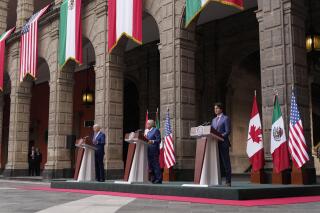US didn’t sign away sovereignty with North American agreement

President Joe Biden, Mexican President Andres Manuel Lopez Obrador, and Canadian Prime Minister Justin Trudeau participate in a news conference at the 10th North American Leaders’ Summit at the National Palace in Mexico City, Tuesday, Jan. 10, 2023. A declaration following the summit has been misinterpreted by social media users. (AP Photo/Andrew Harnik)
CLAIM: The Declaration of North America, which President Joe Biden signed on to this month, will strip the U.S. of its sovereignty in order to form a pan-North American government.
AP’S ASSESSMENT: False. The declaration doesn’t impose obligations on the U.S. or change its status as a sovereign country, a foreign policy expert told The Associated Press. It lays out some broad commitments to goals like diversity and sustainability, but is not legally binding. A hypothetical treaty to alter the U.S.’ relationship with Canada and Mexico in such a way would require the Senate’s approval.
THE FACTS: Trilateral talks between Biden, Mexican President Andrés Manuel López Obrador and Canadian Prime Minister Justin Trudeau concluded earlier this month with cautious optimism, as the leaders sought to downplay their disagreements over trade and migration.
To cap the two-day summit, the three laid out a list of mutual commitments called the Declaration of North America. Some online have falsely suggested that the pact is the first step in merging the U.S. into a North American megastate.
“Did you know that the United States of America as you know it no longer exists?” asks a person in a widely-shared YouTube video, which has since spread to Instagram and Twitter.
“While no one was paying attention, Joe Biden signed away our sovereignty as a nation,” the person adds, referring to the Declaration of North America.
The declaration isn’t binding — or anywhere near that extreme.
“This announcement is basically happy talk about cooperation between the three governments and creates no new legal obligations,” said Walter Olson, a senior fellow at the Cato Institute who studies constitutional law.
The declaration reaffirms previous joint efforts between the U.S., Mexico and Canada, such as working together to “promote buy-in for ambitious cuts to emissions” to meet the goals set by the Paris Agreement. It promises to ensure “safe, orderly, and humane migration” and to combat racism and gender-based violence.
“As we work to implement these commitments in the upcoming year, we seek to model a democratic and sustainable path based on trust to promote inclusive prosperity and security,” the declaration concludes.
It falls well short of a deal to completely restructure three countries.
“It is true that when actual treaties are written and ratified there can be effects on U.S. sovereignty. That can be an area of concern,” Olson said. “But no new treaty is being created here.”
Under the U.S. Constitution, a treaty is an international agreement that has been approved by a two-thirds majority of the Senate. Because the Declaration of North America did not go through the Senate ratification process, any commitments within it would not be legally binding, Olson said.
Asked for comment, the State Department referred The Associated Press to the White House’s statement on the declaration, as well as the text of another agreement made the same day. That pact, signed by Secretary of State Antony Blinken and his counterparts in the Mexican and Canadian governments, focuses more narrowly on ways to “advance equity and racial justice.”
—
This is part of AP’s effort to address widely shared misinformation, including work with outside companies and organizations to add factual context to misleading content that is circulating online. Learn more about fact-checking at the AP.
